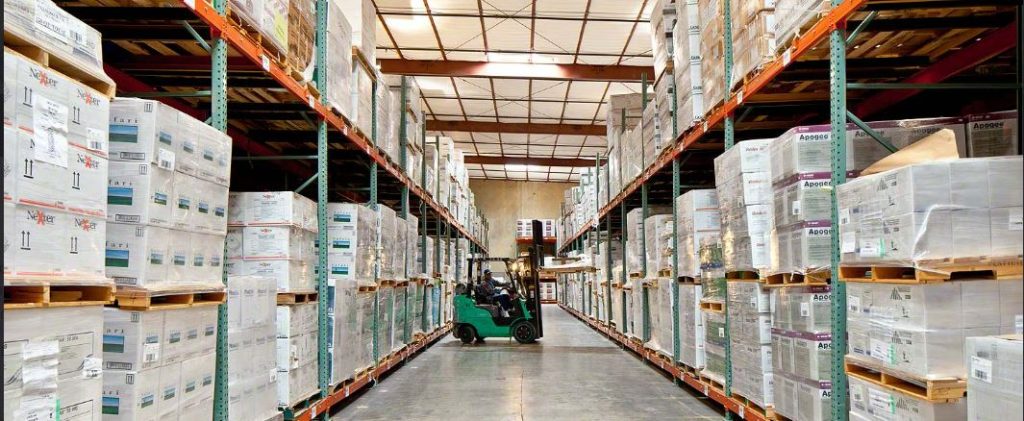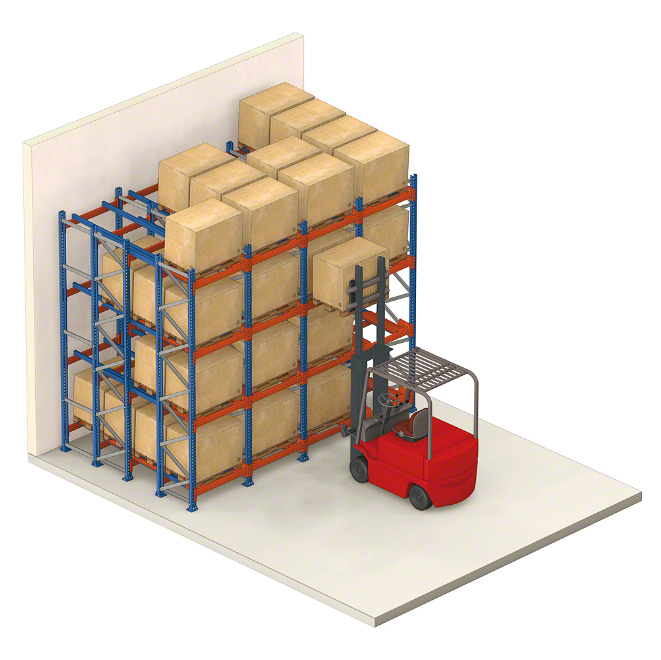Pushback racking is a high-density storage solution where pallets are pushed back when new pallets are loaded. It utilizes gravity to store and unload the pallets. When you remove the first pallet, the remaining come forward since the rails are inclined a bit.
And when a pallet is loaded, it pushes the existing along the rails. The system optimizes warehouse space and improves storage and retrieval efficiency.
Push-back racks allow storage of 2 to 6 deep per lane, making it a perfect option for multiple of the same SKU (Stock Keeping Unit).
Anatomy Of a Push-Back Racking System
- Frame: Frames are the skeleton of push-back racking, consisting of vertical posts and horizontal supports.
- Beams: Beams are primarily horizontal bars connecting the vertical posts to the frame, supporting and distributing the weight.
- Post Protectors: These are guards placed under the vertical post to prevent damage.
- Shuttle/Nested cart: These are moveable carts holding the pallets for moving from front to back and vice versa.
- Rollers: Rollers are small wheels of the carts, allowing the shuttle to move.
- Pallet Backstops: Backstops are the barrier protecting it from rolling off the racks.
- Rails: The rails are 2-3 degree inclined tracks on which nests and pallets move.
- Pallet Guides or Grips: Additional components to keep them in the right position.
What is push back racking Features
Multiple deep
Push-back racking allows 2 to 6 pallets to be stored in a single lane. Besides, it has fewer aisles, which increases storage capacity and optimizes space.
Inclined rails
The system uses slightly inclined rails (2-3 degrees) to facilitate the pallet movement. They are angled so that the rest can come forward automatically when a pallet is removed.
LIFO stock management
Pushback rack systems operate in the LIFO (Last in, first out) stock management system. That means the last item stored will be the first one to be retrieved.
Selective accessibility
Push-back pallet racking systems offer easy accessibility to the last item stored. When the last item is removed, the previous pallets are forwarded for retrieval.
Steel construction
The racks are made of steel frames to provide sturdiness and strength. They also handle heavy weight loads. Learn about the pallet rack weight capacity.
Types of Push-Back Racking
- Push-back with carts: This system uses a series of shuttles or carts to move along the inclined rails.
- Push-back with rollers: On the other hand, this system uses inclined rollers instead of carts. The key difference is the mechanism. Cart systems use individual carts, whereas roller systems use continuous roller tracks.
Advantages of Push-Back pallet racking LIFO systems
Higher Storage Density
Push-back racking offers higher storage density with 2-6 pallets deep. Besides, the system reduces the number of aisles, improving space utilization. Businesses with higher storage needs can benefit from it. This is suitable for places where warehouse spaces are expensive.
Rapid loading and unloading
The rack uses gravity, making loading and unloading easier. Whenever the last item is unloaded, the remaining items roll forward for easy unloading.
Reduce the risk of racking and product damage.
The system does not require the forklift to go into racks. It prevents unwanted collisions and keeps the racks and products safe. vol
Improved product selectivity
The last item is always available to access. It improves product selectivity.
Adaptable to product size and type
Each channel can store different types of products. That means you can store products in different sizes and types. You can even use different-sized products in the same channel, though it will reduce efficiency.
Temperature adjustment
Racks can easily withstand -30 °C to 40 °C, making them perfect for almost any temperature. This makes the system suitable for cold storage and other distributions.
Low maintenance
The rack components are strong enough to withstand heavy weight loads. It also requires less maintenance.
Disadvantages of Push-Back Racking
Limited compatibility with perishable goods
Since Push-back pallet racks operate in the LIFO stock management system, they are unsuitable for perishable products.
Specific storage depths
Using different-sized SKUs will reduce space efficiency.
Lost of vertical storage space
Since the rails are inclined, a bit of vertical space is compromised.
No direct access to all the pallets
Pushback racking systems work in the LIFO method, which prevents access to all the pallets. It makes the system unsuitable for businesses with higher inventory turnover.
Factors to Consider When Choosing Push-Back Racking
- Storage needs: Consider how much storage you need.
- Floor space requirement: Measure the floor area and see whether push-back racking suits it.
- Product Type: Pushback racks are good for the same SKUs. Make sure you are going to store the same SKU.
- Weight limit: Understand the weight limit and see whether the system can handle your needs.
- Inventory Turnover Rate: A pushback system suits businesses with lower inventory turnover. Understand your business and calculate your turnover rate.
Who Should Use Push Back Racking?
- Food and beverages
- Cold storage
- Distribution center
Comparison with Other Pallet Rack Systems
| Criteria | Push Back Racking | Selective Racking | Drive-in rack | Pallet Flow Racking (FIFO) | Cantilever Racking |
| Storage Density | High (2-6 pallets deep) | Low (Single pallet deep) | Very High (Deep lanes, 20+ pallets) | High (Deep lanes, continuous flow) | Low (Designed for long, bulky items) |
| Inventory Rotation | LIFO (Last-In, First-Out) | FIFO (First-In, First-Out) | LIFO (Last-In, First-Out) | FIFO (First-In, First-Out) | N/A (Typically for non-palletized items) |
| Product Access | Moderate (Front pallet accessible) | High (Each pallet is directly accessible) | Low (Requires removal of front pallets) | High (First pallet in is the first pallet out) | Moderate (Items accessible depending on height) |
| SKU Variety | Moderate (Limited by lane depth) | High (Each pallet can be a different SKU) | Low (Best for identical SKUs per lane) | High (Good for various SKUs) | High (Can store a wide variety of items) |
| Capital Cost | Moderate to High (Depends on system complexity) | Low to Moderate (Simple design) | Moderate (Requires robust structure) | High (Complex system with rollers) | Moderate to High (Depending on customization) |
FAQ
Do I need to use special forklifts for pushback racking?
No, you do not need to use any special forklifts. Any kind of forklift will work.
What should be the aisle size for push-back pallet racking?
6″ aisle size is suitable for pushback racking.
What is the temperature restriction of push-back racks?
The temperature restriction of the push-back rack systems is -30 °C to 40 °C.
Wrapping up
Push-back pallet racking is a high-density storage system, a perfect solution for businesses needing to store large quantities of the same SKU (Stock Keeping Unit). It utilizes the warehouse space and improves efficiency and productivity. Businesses with medium to lower inventory turnover rates will greatly benefit from it. So, understand your business needs and pick the right rack system to maximize profit.
Ready to change the way you store things in your warehouse? Matco Distributor has top-of-the-line push-back shelving solutions that can be customized to fit your needs. Whether you want to get selective pallet racks, drive-in pallet racks, or Pallet flow, our expert team is here to help you every step of the way.
Do not settle for less when it comes to storage. Contact us right away to set up a personal meeting and begin the process of making your building smarter and more efficient.
Get in touch with Matco Distributor right away, and let’s begin!


